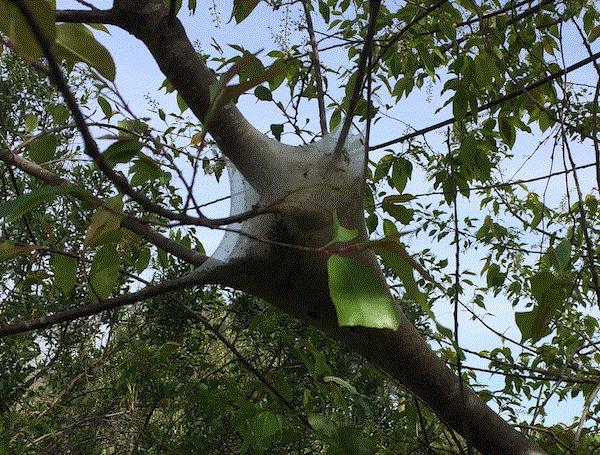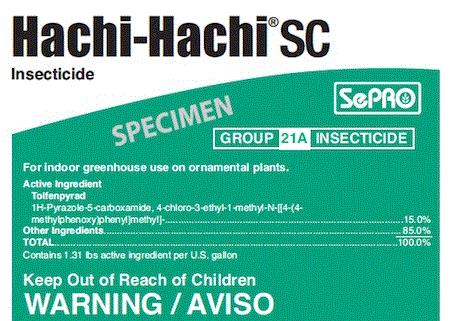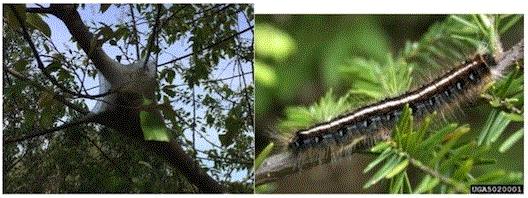What the ... ?
This week’s “What the … ?” creature is an easy one. You’ll see these webs or nests on the crotch of trees, most frequently wild cherry, apple and crabapple. What do y’all think it is? The answer is at the end of this newsletter.

By the way, y’all probably notice by now that my “What the … ?” section features exclusively insects from the East. Folks out west, tell me what’s going on where you are and educate me. Stump me with your bugs and diseases.
Speaking of the West …
Hachi-Hachi SC now registered for CA
SePRO announced this week that Hachi-Hachi SC is now registered in California. I still cannot find Hachi-Hachi SC in the New York State Bureau of Pest Management database. Sorry, folks of the Empire State.

The active ingredient of Hachi-Hachi SC is tolfenpyrad, an IRAC (Insecticide Resistance Action Committee) Group 21A or METI insecticide. Hachi-Hachi SC inhibits normal functions of mitochondrial electron transport complex I (thus the acronym METI), which in turn inhibits energy production in insects and mites. This IRAC Group also includes fenazaquin (Magus), fenpyroximate (Akari) and pyridaben (Sanmite). Do not rotate Hachi-Hachi SC with Magus, Akari and Sanmite.
Hachi-Hachi SC is developed by Nichino and marketed by SePRO. Currently, use is limited to greenhouse (REI = 12 hours) but outdoor use is being evaluated. Target pests are aphids, scale insects, mealybugs, leafhoppers, thrips and caterpillars, with suppression of whiteflies. Interestingly, Hachi-Hachi SC also suppresses powdery mildew. Although Hachi-Hachi SC is in the same IRAC Group as the miticides Magus, Akari and Sanmite, spider mite is not a target. Application rate ranges from 21 to 32 fl. oz. per 100 gal., with a limit of 2 applications or 64 fl. oz. per 100 gal. per crop cycle.
The formulation of Hachi-Hachi was changed from EC to SC around 2013. Although crop safety was improved with the change in formulation, SePRO continues to advise against applying Hachi-Hachi SC on salvia, impatiens, New Guinea impatiens, baby’s breath (gypsophila), phlox, poinsettia with bracts in color and petunia in bloom. Temporary phytotoxicity can also appear on some species of ageratum, colocasia, geranium, ground orchid, lobelia, marigold, pansy, verbena and vinca. Always test for phytotoxicity on a small set of plants before application.
I didn't have a chance to work with Hachi-Hachi 15EC when it was evaluated by IR-4 in 2006 to 2009. Y’all can find a summary of IR-4’s many efficacy and crop safety trials here. Briefly, Hachi-Hachi 15EC provided good to excellent efficacy against chili thrips and western flower thrips, with its efficacy similar to those of Conserve and Avid. Hachi-Hachi 15EC was not effective against several leaf beetle, ambrosia beetle and clearwing borer species in the IR-4 trials.
I have had a chance to evaluate the efficacy of Hachi-Hachi SC against western flower thrips in the greenhouse and chilli thrips in an outdoor nursery in the past three years. Thrips management in the southern US and in outdoor production is challenging because thrips are constantly being blown in from the surrounding fields. Faced with this challenging condition, I didn't observe particularly high efficacy with two applications of Hachi-Hachi SC, Conserve and Avid. For growers with open greenhouses or production facilities, I would suggest two applications of Hachi-Hachi SC at 32 fl. oz. per 100 gal. to avoid build up of the thrips population on your crops. For those with closed greenhouses, you should see good control of thrips with Hachi-Hachi SC based on IR-4’s data.
Just in case you ever wonder, hachi is the number eight in Japanese, and so “Hachi-Hachi” means 88. Why “88”? Well, you stumped me there.

New aquatic herbicide from SePRO
This is a busy week for folks at SePRO. SePRO announced this week that a new aquatic herbicide, called ProcellaCOR (“heart of the storm” in Latin), has received federal registration. State registrations will come at later dates as SePRO works through the process. Only a limited amount of information is available at this time.
The active ingredient of ProcellaCOR is florpyrauxifen-benzyl, a member of a new chemical family called arylpicolinate (HRAC Group O or WSSA Group 4). This is a synthetic auxin herbicide, which works by disrupting normal plant growth. The active ingredient was originally developed by Dow AgroSciences (called Rinskor active) and currently available as Loyant for rice production in the US.
ProcellaCOR is highly selective. Its targets include hydrilla, Eurasian and hybrid watermilfoils, crested floating heart and water hyacinth. Studies conducted by Drs. Mike Netherland and Mark Heilman in Texas suggested low or no activity on tapegrass, stargrass, common waterweed, and Illinois and American pondweeds. ProcellaCOR can only be applied by professionals certified by SePRO.
EPA classified ProcellaCOR as a reduced-risk herbicide because it breaks down quickly in water under full sun and has low to no toxicity to humans and wildlife. The product will have no drinking water or recreational use restrictions. This is a welcoming feature for managers of drinking water sources and professionals managing waterways or ponds choked with aquatic weeds. Folks in Florida can finally take their boats out for a ride again.
As a side note, Valent and NuFarm announced on February 14, 2018 that NuFarm is now the exclusive distributor of Valent’s herbicides in the Industrial Vegetation Management (IVM) market (highways, railroads, utilities and pipelines). With this agreement, NuFarm’s portfolio will include Envoy Plus, Payload and Piper for IVM, Aqua Neat, AquaSweep, Diquat SPC, Clipper and Tradewind for aquatic, and many more for the turf and ornamentals market.

Research funding from AFE, HRI and USDA
In mid-February, Horticultural Research Institute (HRI) announced a funding of $232,000 to support 10 research projects in 2018. Research projects include studies to improve management of amber snail, azalea lace bug and black root rot, develop phytophthora-resistant annuals and perennials, document environmental fate and management of nitrogen in container nurseries, improve hydroponic stock plant systems for nursery crops, understand visual cues that could be important to making purchase decisions by consumers, and continue the Seed Your Future movement to promote horticulture among the next generation.
The 2018 research program also continues HRI’s sustained initiative in boxwood blight management by funding two research projects. Dr. Jill Calabro, HRI’s director of science and research programs, summarizes some of the recent boxwood blight research in a recent issue of Nursery Management magazine.
American Floral Endowment (AFE) announced in mid-March that nearly $300,000 will be provided to support 10 new and continuing research projects in 2018 and 2019. AFE launched its Botrytis and Thrips Research Campaign in 2017 with the goal of raising $1.5 million for research in these two devastating pests. As part of this campaign, research projects funded in 2018 and 2019 will investigate various tools (including UV light, entomopathogenic fungi, biopesticides and predatory mites) for managing thrips and reducing botrytis and thrips damage through calcium and silicon supplementation (Disclosure: I am part of this project).
Other funded projects include developing seed-propagated downy mildew resistant impatiens. Another project will investigate the mechanism and potential of improving cut flower longevity through inhibiting ethylene. Two projects will work on improving lighting for crop production and energy savings. The project that really piqued my interest is one that aims to develop a drone for monitoring plant pests. If drone-scouting proves successful, it may change the way we scout completely.
Research projects to develop management tools and technologies for important pests, be it thrips, botrytis, or boxwood blight, are expensive. AFE and HRI are supported by our industry and doing their best in funding these research projects, allowing my colleagues and I to help improve the economics of our industry. Do your part to support AFE and HRI.
Also announced last week was the allocation of about $70 million to USDA-APHIS from the 2014 Farm Bill (a.k.a. the Agricultural Act of 2014), which provides funding for agricultural programs in 2014 to 2018. Funding is allocated yearly, and the current allocation is the last payment from the 2014 Farm Bill. About $50 million will support plant pest and disease detection, diagnosis, management and education in invasive pests, such as sudden oak death and giant African snail. $14 million will be provided to Plant Pest Rapid Response to develop invasive pest detection programs and respond to invasive pest emergencies such as spotted lanternfly quarantine and treatment. $6 million will be allocated to the National Clean Plant Network to propagate high-quality, pest-free specialty crop materials.

Will machines replace pollinators?
Speaking of drones, here is news from the weird. James Hetherington of Newsweek reported in March that Walmart has filed for a patent for a “pollinator drone.” The explicit purpose of the drone is to pollinate flowers and maintain crop production as “the amount of pollinators … has been in steady decline …” The drone is complete with cameras and sensors to identify pollen and bristles to extract and hold the pollen.
I don't know how I feel about the underlying premise of this patent. A little perturbed, but mostly wondering if it’s really necessary. I personally don't think we’ve reached the end of the road for pollinators that their jobs have to be done by machines. You and I are working hard to make sure the bees will be around for many years to come. Nature is also much more adaptable than we think. Remember what Dr. Ian Malcolm (played by Jeff Goldblum) said in Jurassic Park? “Life uh … finds a way.”
Okay, maybe I read a little bit too much into that patent. (Have y’all ever read a patent application? Almost as confusing as a tax bill. There’s a link for the patent in the Newsweek article.) Maybe Walmart just wants to get its feet into the unmanned aerial vehicle technology sector, or as it implies in the patent application, to replace the inefficient crop dusters. But who uses crop dusters to pollinate crops? I digress.
The "What the ... ?" is ...
The “What the … ?” creature is an eastern tent caterpillar nest, or to my nerdy friends, the nest of Malacosoma americanum. As the scientific name implies, this is a very common native species in the eastern US.

Eastern tent caterpillar (right) and its nest (left). (Photo credit: nest, JC Chong; caterpillar, Pennsylvania Department of Conservation and Natural Resources - Forestry, bugwood.org.)
I saw this one on a wild cherry tree right outside of my office. By the time I noticed the nest, the caterpillars have vacated the nest. Where did they go? When the caterpillars mature, they wander around looking for a good place to pupate. This is often when folks see them and get freaked out by them. No, the caterpillar is not zooming in on your precious rose bush. In fact, it’s fully mature and won't even be eating at this time. I think the caterpillars are quite pretty. I wouldn't try to control them, unless you’re allergic to them or you breed thoroughbreds for a living. Eastern tent caterpillar is closely associated with mare reproductive loss syndrome. Similar symptoms are not known in animals other than horses and camels.
Look around and y’all will find the nest nearby, often built at the crotch of a wild cherry, apple, crabapple, hawthorn or another tree. There are dozens to hundreds of caterpillars in each nest. The caterpillars are protected in the nest during the day and come out to munch on leaves at night. There’s only one generation per year. If y’all miss them now, you’ll have to wait till next spring. They're common in the spring in the eastern US and southern Canada, but only occasionally in the western half of North America.
Got to go. My wife is bringing home “a part of a pig” and some “yard birds,” “cooked on the side of the road.” She knows where to find the best grub. Can't wait. Thank you, love!





See y'all next time!

JC Chong
Associate Professor of Entomology at Clemson University
This e-mail received by 24,525 subscribers like you!
If you're interested in advertising on PestTalks contact Kim Brown ASAP!